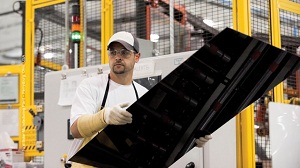Despite remaining profitable for 2012 First Solar can’t assuage market
 Prior to reporting its full-year 2012 results yesterday evening (Feb. 26) First Solar announced that it’s reached a new efficiency level for cadmium telluride (CdTe) thin-film photovoltaics, at 18.7 percent efficiency (as verified by the National Renewable Energy Laboratory). Then during the earnings report, the company produced non-GAAP earnings per share of $2.04 for the fourth quarter beating street EPS estimates of $1.75. But that wasn’t enough to assuage investors and the stock opened at $26.87 on Feb. 27, down from closing at $31.36 the day before.
Prior to reporting its full-year 2012 results yesterday evening (Feb. 26) First Solar announced that it’s reached a new efficiency level for cadmium telluride (CdTe) thin-film photovoltaics, at 18.7 percent efficiency (as verified by the National Renewable Energy Laboratory). Then during the earnings report, the company produced non-GAAP earnings per share of $2.04 for the fourth quarter beating street EPS estimates of $1.75. But that wasn’t enough to assuage investors and the stock opened at $26.87 on Feb. 27, down from closing at $31.36 the day before.
The company’s results reflected the challenging market all solar companies are facing, according to Raymond James Equity Research Analyst Pavel Molchanov. In a research note, he wrote: “While the balance sheet is healthy, and the company has stayed profitable thanks to its legacy U.S. utility-scale projects, as those gradually roll off we envision progressively lower levels of profitability. We maintain our underperform rating, a negative stance on par with the three other module makers we cover: SunPower, Suntech, and Trina.”
For the fourth quarter of 2012 First Solar reported net sales of $1.1 billion, $236 million more than the previous quarter and $415 million more than the previous year’s fourth quarter. The company attributed the increase to increased revenue recognition from the Topaz project as well as an increase in third-party module sales. That resulted in the GAAP EPS of $1.74 for the quarter, up over the $1.00 EPS for the third quarter, and over the loss per share of $4.78 reported for the fourth quarter of 2011. For full year 2012 First Solar reported a GAAP loss of $1.11 per share.
However, 2012 is the first year under First Solar’s new leadership and new strategic direction, CEO James Hughes reminded investors and analysts during the company’s earnings call. “A little over a year ago, we took the bold step of announcing a fundamental change to our strategic plan to transition from traditional subsidized markets towards sustainable high growth markets with the fundamental need for energy and higher radiance levels where solar can compete economically with other existing energy sources,” he said. To move in that direction the company made a number of changes, including scaling business for the markets, establishing local presence in its target markets, establishing relationships with strategic partners, reducing operating and system costs to compete without subsidies and providing services that work with the local grid.
However, the results and plan were not enough to assuage the concerns of Molchanov, who observed that CdTe's cost advantage has shrunk. “While we applaud management's refusal to chase market share by competing on pricing with crystalline modules, the end result is shaping up to be the same, i.e. falling profitability. While First Solar's gross margins are holding up better than those of all other major module producers, we still project a decline to 19 percent by 4Q13. Concurrently, we project zero top-line growth in 2013 and a slight bounce in 2014. We had already been 15 percent below the street for 2013, and today we are cutting our EPS estimate further to $3.40. However, we project an even steeper year-over-year EPS decline, to $2.00, in 2014,” he said.
How soon First Solar is able to bring those higher efficiency modules to market could impact that, but when it will be ready to produce those remains to be seen. Meanwhile the company guided net sales of $650 to $750 million for the first quarter of 2013 with EPS of 70 cents to 90 cents per fully diluted share.



